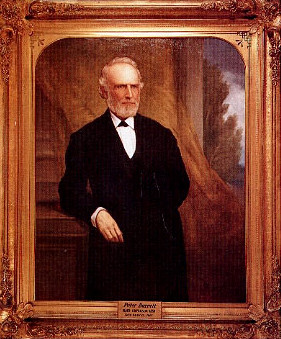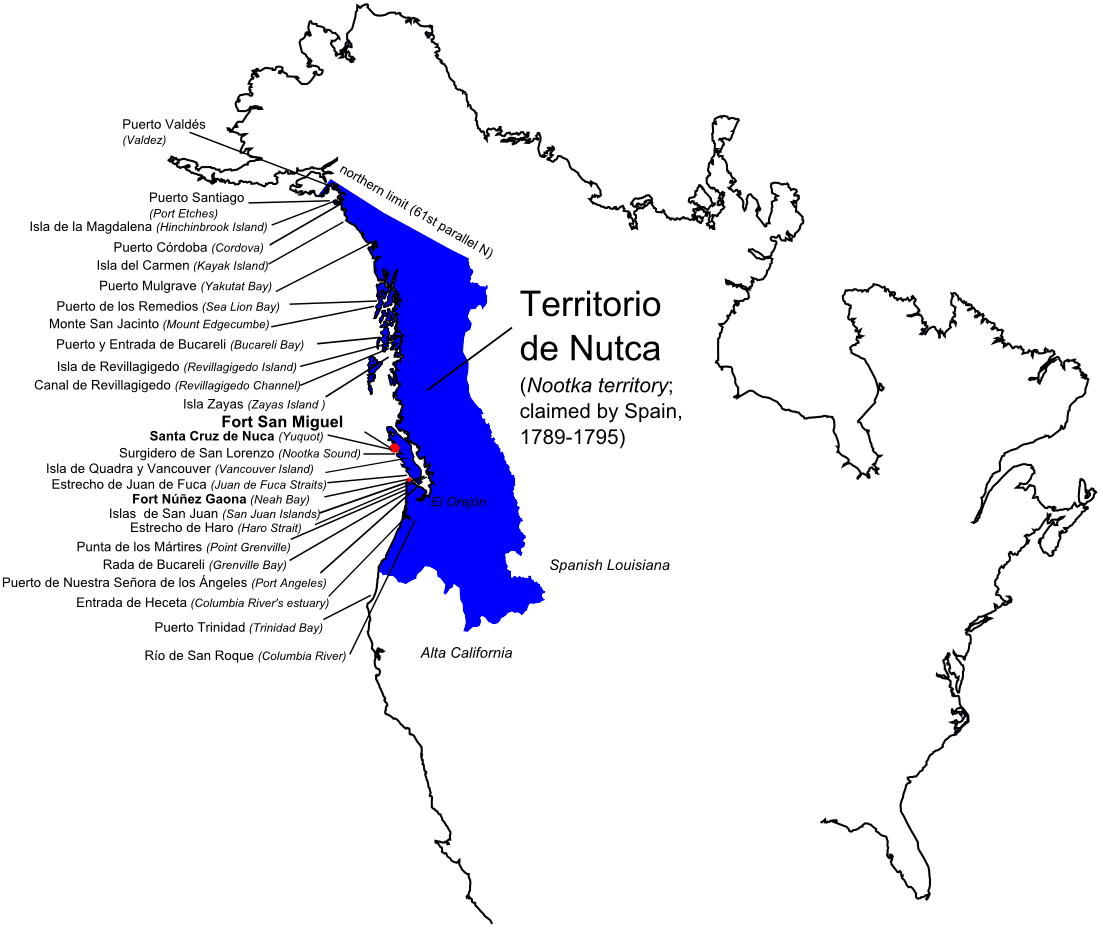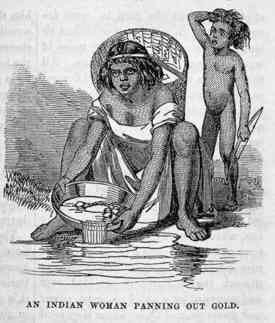|
Peter Burnett
Peter Hardeman Burnett (November 15, 1807May 17, 1895) was an American politician who served as the first elected Governor of California from December 20, 1849, to January 9, 1851. Burnett was elected Governor almost one year before California's admission to the Union as the 31st state in September 1850. Raised in a slave-owning family in Missouri, Burnett moved westward after his career in business left him heavily in debt. Initially residing in Oregon Country, he became Supreme Judge of the Provisional Government of Oregon. While in Oregon politics, he pushed for the total exclusion of African-Americans from the territory. He authored the infamous "Burnett's lash law" that authorized the flogging of any free blacks who refused to leave Oregon; the law was deemed "unduly harsh" and went unenforced prior to voters rescinding it in 1845. In 1848, Burnett moved to California during the height of the California Gold Rush. He re-established his political career and was appointed ... [...More Info...] [...Related Items...] OR: [Wikipedia] [Google] [Baidu] |
Governor Of California
The governor of California is the head of government of the U.S. state of California. The governor is the commander-in-chief of the California National Guard and the California State Guard. Established in the Constitution of California, the governor's responsibilities also include making the annual State of the State address to the California State Legislature, submitting the budget, and ensuring that state laws are enforced. The position was created in 1849, the year before California became a state. The current governor of California is Democrat Gavin Newsom, who was inaugurated on January 7, 2019. Gubernatorial elections, oath, and term of office Qualifications A candidate for governor must be a U.S. citizen and a registered voter within the state, must not have been convicted of a felony involving bribery, embezzlement, or extortion, and must not have served two terms since November 6, 1990. Election and oath of Governor Governors are elected by popular ballo ... [...More Info...] [...Related Items...] OR: [Wikipedia] [Google] [Baidu] |
Oregon Country
Oregon Country was a large region of the Pacific Northwest of North America that was subject to a long dispute between the United Kingdom and the United States in the early 19th century. The area, which had been created by the Treaty of 1818, consisted of the land north of 42°N latitude, south of 54°40′N latitude, and west of the Rocky Mountains down to the Pacific Ocean and east to the Continental Divide. Article III of the 1818 treaty gave joint control to both nations for ten years, allowed land to be claimed, and guaranteed free navigation to all mercantile trade. However, both countries disputed the terms of the international treaty. Oregon Country was the American name while the British used Columbia District for the region. British and French Canadian fur traders had entered Oregon Country prior to 1810 before the arrival of American settlers from the mid-1830s onwards, which led to the foundation of the Provisional Government of Oregon. Its coastal areas north from ... [...More Info...] [...Related Items...] OR: [Wikipedia] [Google] [Baidu] |
Unfree Labor In California
Forced labor in California existed as a system technically different but similar to chattel slavery. While California's state constitution outlawed slavery, the 1850 Act for the Government and Protection of Indians allowed the indenture of Native Californians. The act allowed for a system of custodianship for indigenous children and a system of convict leasing. These systems were backed by the legalized corporal punishment of any Native Californian, and the stripping of many legal rights of Native Californians. Background Spanish California Pre-European contact, the population of native Californian Indians estimates vary, ranging from 300,000 to nearly one million. In 1542, Spanish explorer Juan Rodriguez Cabrillo first landed in California, but the region wasn't successfully settled by the Spanish until 1769. In 1769, Padre Junípero Serra founded the first Spanish mission in California, Mission San Diego, el Misión San Diego de Alcalá. The padres would often Baptism#Cat ... [...More Info...] [...Related Items...] OR: [Wikipedia] [Google] [Baidu] |
Act For The Government And Protection Of Indians
The Act for the Government and Protection of Indians (Chapter 133, Cal. Stats., April 22, 1850), nicknamed the Indian Indenture Act was enacted by the first session of the California State Legislature and signed into law by the 1st Governor of California, Peter Hardeman Burnett. The legislation led to the forced labor of many Native Americans in California, in addition to regulating employment terms and redefining criminal activity and punishment. The legislation played a crucial role in sanctioning the California genocide, in which thousands of Native Californians were killed or enslaved by white settlers during the California Gold Rush. Burnett, who signed the bill into law, explained in 1851 " at a war of extermination will continue to be waged between the races until the Indian race becomes extinct must be expected”. At the time of the legislation's passage, Native Californians were ineligible to become citizens, vote, or testify in court. The act facilitated the removal a ... [...More Info...] [...Related Items...] OR: [Wikipedia] [Google] [Baidu] |
African Americans In California
African American Californians or Black Californians are residents of the state of California who are of African ancestry. According to 2019 United States Census Bureau estimates, those identified solely as African American or black constituted 5.8% or 2,282,144 residents in California. Including an additional 1.2% who identified has having partial African ancestry, the figure was 7.0% (2.8 million residents). The Black community is prevalent in Alameda, Contra Costa, San Francisco, and Solano Counties in the San Francisco Bay Area, Sacramento County, and San Joaquin County. In Southern California, the population is concentrated in Los Angeles County, San Bernardino County, and San Diego County. California also has a growing Afro-Caribbean and Sub Saharan African population to the United States. Most Sub Saharan Africans in California come from Ethiopia and Eritrea. Many Ethiopians live in Little Ethiopia in West Los Angeles. California has one of the highest concentrat ... [...More Info...] [...Related Items...] OR: [Wikipedia] [Google] [Baidu] |
Slave States And Free States
In the United States before 1865, a slave state was a state in which slavery and the internal or domestic slave trade were legal, while a free state was one in which they were not. Between 1812 and 1850, it was considered by the slave states to be politically imperative that the number of free states not exceed the number of slave states, so new states were admitted in slave–free pairs. There were, nonetheless, some slaves in most free states up to the 1840 census, and the Fugitive Slave Act of 1850 specifically stated that a slave did not become free by entering a free state. Although Native Americans had small-scale slavery, slavery in what would become the United States was established as part of European colonization. By the 18th century, slavery was legal throughout the Thirteen Colonies, after which rebel colonies started to abolish the practice. Pennsylvania abolished slavery in 1780, and about half the states abolished slavery by the end of the Revolutionary War or ... [...More Info...] [...Related Items...] OR: [Wikipedia] [Google] [Baidu] |
Sacramento, California
) , image_map = Sacramento County California Incorporated and Unincorporated areas Sacramento Highlighted.svg , mapsize = 250x200px , map_caption = Location within Sacramento County in California , pushpin_map = California#USA , pushpin_label = Sacramento , pushpin_map_caption = Location within California##Location in the United States , pushpin_relief = yes , coordinates = , coordinates_footnotes = , subdivision_type = Country , subdivision_name = United States , subdivision_type1 = State , subdivision_name1 = California , subdivision_type2 = County , subdivision_name2 = Sacramento ---- , subdivision_type3 = Region , subdivision_name3 = Sacramento Valley , subdivision_type4 = CSA , subd ... [...More Info...] [...Related Items...] OR: [Wikipedia] [Google] [Baidu] |
Fugitive Slaves In The United States
In the United States, fugitive slaves or runaway slaves were terms used in the 18th and 19th century to describe people who fled slavery. The term also refers to the federal Fugitive Slave Acts of 1793 and 1850. Such people are also called freedom seekers to avoid implying that the slave had committed a crime and that the slaveholder was the injured party. Generally, they tried to reach states or territories where slavery was banned, including Canada, or, until 1821, Spanish Florida. Most slave law tried to control slave travel by requiring them to carry official passes if traveling without a master. Passage of the Fugitive Slave Act of 1850 increased penalties against runaway slaves and those who aided them. Because of this, some freedom seekers left the United States altogether, traveling to Canada or Mexico. Approximately 100,000 American slaves escaped to freedom. Laws Beginning in 1643, the slave laws were enacted in Colonial America, initially among the New England Conf ... [...More Info...] [...Related Items...] OR: [Wikipedia] [Google] [Baidu] |
Archy Lee
Archy Lee was an African-American born into slavery in Mississippi in 1840. Lee's slave-owner, Charles Stovall, brought Lee with him to Sacramento, California on October 2, 1857. While in California, Stovall rented out Lee for his wages. In January 1858, when Stovall decided to return to Mississippi, Lee, age 18, escaped from Stovall while en route to the bay and went back to Sacramento. Lee took refuge in the home of Charles Hackett and Charles Parker, two politically active African-Americans in Sacramento who operated a hotel, the Hackett House (on Third Street between K and L). Stovall had Lee arrested, but a prominent civil rights attorney, Edwin B. Crocker defended Lee, and in decision on January 26, 1858, Judge Robert Robinson ruled that Lee was a free man because California was a free state and, though Mississippi was a slave state, Stovall had become permanent resident of California, and thus could not own slaves. Judge Robinson's decision was appealed to the California Sup ... [...More Info...] [...Related Items...] OR: [Wikipedia] [Google] [Baidu] |
Supreme Court Of California
The Supreme Court of California is the Supreme court, highest and final court of appeals in the judiciary of California, courts of the U.S. state of California. It is headquartered in San Francisco at the Earl Warren Building, but it regularly holds sessions in Los Angeles and Sacramento. Its decisions are binding on all other California State court (United States), state courts. Since 1850, the court has issued many influential decisions in a variety of areas including torts, property law, property, Civil and political rights, civil and constitutional rights, and criminal law. Composition Under the original 1849 California Constitution, the Court started with a chief justice and two associate justices. The Court was expanded to five justices in 1862. Under the current 1879 constitution, the Court expanded to six associate justices and one chief justice, for the current total of seven. The justices are appointed by the Governor of California and are subject to retention electio ... [...More Info...] [...Related Items...] OR: [Wikipedia] [Google] [Baidu] |
California Gold Rush
The California Gold Rush (1848–1855) was a gold rush that began on January 24, 1848, when gold was found by James W. Marshall at Sutter's Mill in Coloma, California. The news of gold brought approximately 300,000 people to California from the rest of the United States and abroad. The sudden influx of gold into the money supply reinvigorated the American economy; the sudden population increase allowed California to go rapidly to statehood, in the Compromise of 1850. The Gold Rush had severe effects on Native Californians and accelerated the Native American population's decline from disease, starvation and the California genocide. The effects of the Gold Rush were substantial. Whole indigenous societies were attacked and pushed off their lands by the gold-seekers, called "forty-niners" (referring to 1849, the peak year for Gold Rush immigration). Outside of California, the first to arrive were from Oregon, the Sandwich Islands (Hawaii) and Latin America in late 1848. ... [...More Info...] [...Related Items...] OR: [Wikipedia] [Google] [Baidu] |





.jpg)

.jpg)


